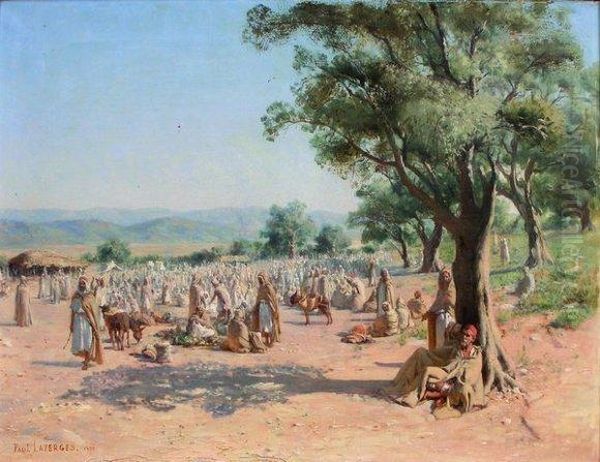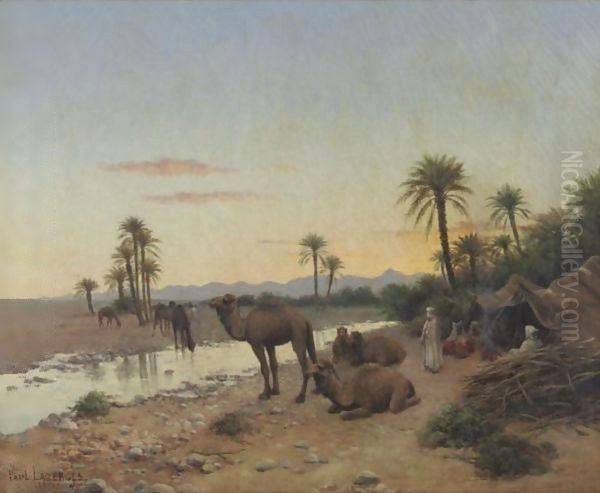Paul Jean Baptiste Lazerges stands as a significant figure in the landscape of 19th-century French art. Born into an artistic family and flourishing during a period of intense European fascination with the East, Lazerges carved a niche for himself primarily as an Orientalist painter, though his talents also extended to portraiture and religious subjects. His long career, marked by consistent participation in the prestigious Paris Salon and the reception of several awards, cemented his reputation as a skilled and sensitive artist whose works captured the perceived poetry and exoticism of North Africa, particularly Algeria.
Parisian Roots and Artistic Inheritance
Born in Paris in 1845, Paul Lazerges entered a world already steeped in artistic tradition. His father was the notable painter Jean Raymond Hippolyte Lazerges (1817-1887), himself an accomplished artist known for historical, religious, and Orientalist scenes, as well as portraits. Growing up under the tutelage and influence of his father, Paul naturally absorbed the techniques and thematic interests prevalent in the academic art world of the time. This familial connection provided not only training but likely also an entry point into the competitive Parisian art scene.
The mid-19th century in Paris was a dynamic period for the arts. The official Salon system, though increasingly challenged by avant-garde movements later in the century, remained the primary venue for artists seeking recognition and patronage. It was within this environment that Paul Lazerges would develop his craft, eventually following in his father's footsteps by focusing significantly on the popular genre of Orientalism.
Embracing the Orientalist Vision
Orientalism, the depiction of North African and Middle Eastern subjects by Western artists, was a dominant and highly fashionable genre in 19th-century European art. Fueled by colonial expansion, travel narratives, and a romantic yearning for the exotic, artists sought to capture the landscapes, people, and cultures of these regions. Paul Lazerges became a dedicated practitioner of this genre, focusing much of his artistic output on scenes inspired by Algeria.

His approach was characterized by a sensitivity to atmosphere and a poetic quality, often noted by critics. Unlike some Orientalists who focused on dramatic historical events or ethnographic detail, Lazerges often seemed drawn to the more lyrical aspects of North African life – the quiet dignity of figures, the vastness of the desert landscape, the play of light on architecture and attire. His paintings frequently featured caravans traversing the desert, Bedouin encampments, and scenes of daily life, rendered with rich color and meticulous composition.
Artists like Eugène Delacroix, with his influential trip to Morocco in 1832, had laid the groundwork for French Orientalism. Later figures such as Jean-Léon Gérôme became masters of detailed, almost photographic realism in their Eastern scenes. Others, like Eugène Fromentin, who was both a writer and a painter, brought a distinct literary sensibility to their depictions of Algeria. Lazerges operated within this established tradition, contributing his own distinct vision, often emphasizing tranquility and the picturesque.
Notable Works and Thematic Focus
Throughout his career, Paul Lazerges produced a considerable body of work. While a comprehensive catalogue remains elusive, several key paintings are frequently cited, showcasing his thematic range and stylistic skills.
His work in portraiture is exemplified by the Portrait of Sarah Bernhardt (1870). Capturing the likeness of the legendary actress early in her career demonstrates his ability to work within this demanding genre, requiring not just technical skill but the capacity to convey personality.
However, his reputation largely rests on his Orientalist paintings. Works like Algiers (1875), Arab March (1882), and Algerian Storyteller (1883) point directly to his primary geographical focus. These titles suggest an interest in both the urban environment of Algiers and the nomadic life of the desert. The theme of the caravan, a quintessential Orientalist motif symbolizing travel, trade, and the vastness of the desert, appears repeatedly in his work, as seen in Arabian Caravan and Caravane près de Biskra (exhibited at the Salon of 1892).
Camp in the Desert (1896) is another significant work, noted for achieving a high price at auction, indicating its appeal to collectors. End of the Day, Train of i.b.r. (1885) (possibly the same or related to Caravan at Sunset) suggests an interest in capturing specific moments and light conditions, imbuing the scenes with atmosphere. His oil paintings were generally praised for their rich palettes and detailed execution.

Beyond painting, Lazerges also explored sculpture, creating a bronze work titled Le méhariste (The Camel Rider), further demonstrating his commitment to Orientalist themes across different media. While religious subjects were also mentioned as part of his repertoire in initial summaries, specific titles are less frequently cited in readily available sources compared to his Orientalist output.
Salon Success and Official Recognition
The Paris Salon was the crucible where artistic reputations were forged in 19th-century France. Paul Lazerges was a remarkably consistent participant, exhibiting his works there for an impressive 33 consecutive years. This dedication highlights his commitment to the official art system and his sustained level of production.
His participation was not merely consistent but also successful. He received several awards over the course of his career, signifying the esteem in which his work was held by the Salon juries. In 1884, he was awarded a Third-Class Medal. This was followed by a Second-Class Medal in 1898. At the Exposition Universelle (World's Fair) of 1900 in Paris, a major international event, he received a Bronze Medal.
Furthermore, Lazerges became a member of the Société des Artistes Français, the organization that took over the running of the Salon from the state in the 1880s. He also held the title of Officier d'Académie, an order of chivalry bestowed by the French government for distinguished service in education and the arts. These accolades place him firmly within the recognized establishment of French artists of his time. His works entered public collections, including the prestigious Louvre in Paris and the Musée des Beaux-Arts in Nantes, as well as university collections like Bucknell University, ensuring their preservation and accessibility.
Navigating the Art World of His Time
Paul Lazerges' career unfolded during a period of profound change in the art world. While he remained largely faithful to the academic and Orientalist traditions, the latter half of the 19th century saw the rise of revolutionary movements that challenged the Salon's dominance. Impressionism, spearheaded by artists like Claude Monet, Camille Pissarro, and Edgar Degas, emerged in the 1870s, prioritizing the fleeting effects of light and contemporary life over historical or exotic subjects.
Following the Impressionists, Post-Impressionist artists such as Vincent van Gogh, Paul Gauguin (who himself sought the exotic, but in the South Pacific rather than North Africa), and Georges Seurat further fragmented the artistic landscape with their highly individual styles and theoretical concerns.
Lazerges, alongside established academic painters like William-Adolphe Bouguereau and Alexandre Cabanel, represented a more traditional approach. While the Impressionists and Post-Impressionists often struggled for recognition initially, Lazerges achieved consistent success within the Salon system. His adherence to Orientalism kept him aligned with a popular and commercially viable genre throughout much of his career. There is no readily available record suggesting direct interaction or correspondence between Lazerges and the leading figures of the avant-garde, or even significant engagement with other prominent Orientalists like Gustave Guillaumet or Théodore Chassériau, beyond sharing the same exhibition spaces and thematic interests. His artistic circle likely revolved more around his father, fellow Salon exhibitors, and the Société des Artistes Français.
Later Years and Legacy
Despite suffering from poor health in his later years, Paul Lazerges continued to paint and exhibit his work. His dedication to his art remained steadfast until his death in 1902. He left behind a legacy as a skilled and sensitive painter, particularly admired for his contributions to the Orientalist genre.
His work is representative of a specific moment in European art history – a time when the "Orient" served as a powerful source of inspiration, fantasy, and artistic exploration for Western artists. Lazerges captured this fascination with a delicate touch and a poetic sensibility, focusing on the picturesque landscapes and traditional life of Algeria. While perhaps not as revolutionary as some of his contemporaries, his consistent presence at the Salon, the awards he received, and the inclusion of his works in museum collections attest to his significance during his lifetime.
Today, his paintings offer valuable insight into the tastes and preoccupations of the late 19th century. They stand as beautifully crafted examples of French Orientalism, appreciated for their technical skill, atmospheric qualities, and their evocative portrayal of a world viewed through a specific European lens. He remains an important figure for understanding the breadth of artistic production in France during an era of both established tradition and radical innovation. His father, Jean Raymond Hippolyte Lazerges, remains a key figure in understanding Paul's artistic lineage, while contemporaries ranging from the arch-academic Gérôme to the revolutionary Monet help define the complex artistic world he inhabited.